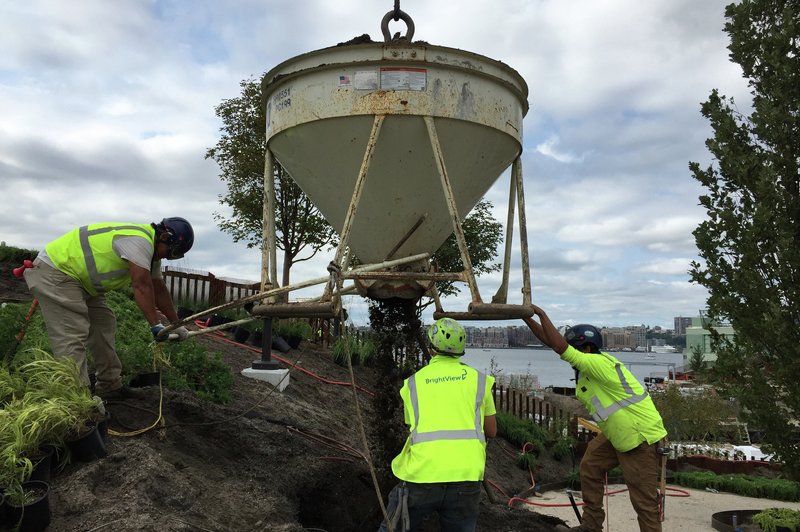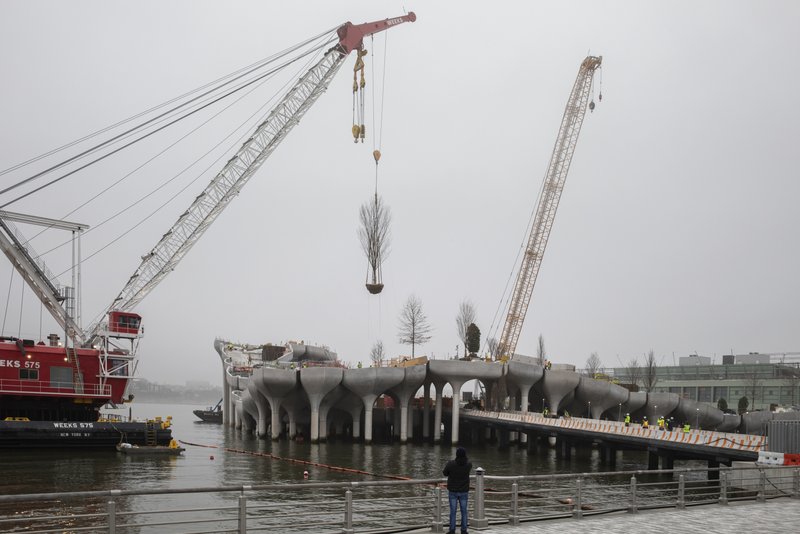
Little Island is a maritime botanic garden with 35 species of trees, 65 species of shrubs, and 290 varieties of grasses, perennials, vines, and bulbs.

MNLA, Heatherwick Studio, Arup, Standard Architects, Fisher Marantz Stone, C&G Partners, Mueser Rutledge Consulting Engineers, Irrigation Consulting, Inc., Hunter Roberts Construction Group (Construction Manager)
MNLA collaborated with Heatherwick Studio to design Little Island (formerly Pier 55), a dramatic 2.4-acre public park in the Hudson River that brings together art and nature in an immersive experience. Conceived as a leaf floating in the water, the pier is a topographic marvel that celebrates views, defines landscaped spaces, and provides resilience against climate change.
The lifted corners of the pier create distinct microclimates that reveal themselves through color, texture, light, and shadow. Whether meandering along paths, stairs, or boulders scrambles, the eye is at times directed downward to the rich palette of plants or outwards to spectacular views of the city and harbor. Little Island is a maritime botanic garden with 35 species of trees, 65 species of shrubs, and 290 varieties of grasses, perennials, vines, and bulbs, many of which have been selected for their fragrance and attractiveness to birds and pollinators. The landscape is one of sweeping swaths of textures and seasonally calibrated color themes punctuated by magnificent trees. Intended to delight and surprise, the captivating landscape offers visitor an oasis from urban life to play, relax, imagine, learn and restore. Additional images and information can be found here.
QUICK FACTS
The idea for the pier came from the existing wooden piles and wondering how a structure could form organically from these rather than being a surface on top
Inspiration for the form of the pots came from looking at the ice patterns that forms around the piles when the water freezes
The precast components were made locally
LITTLE ISLAND'S LANDSCAPE DESIGN
There are roughly 400 different species of trees, shrubs, grasses and perennials throughout Little Island and at least 35 different species of trees through the park that are suited to the New York climate. Each corner of the island represents a different microclimate depending on the topography, sun exposure and wind patterns.
Planting began in March 2020 and culminated in December 2020.
There are roughly 400 different species in the park: 35 trees, 65 shrubs, and 290 varieties of grasses, vines, and perennials.
Different planting typologies define three distinct overlooks—the Northeast, the Southwest, and the Northwest.
More than 66,000 bulbs were planted, including Camassia, Fritillaria, Chinodoxa, Muscari and Narcissus.
The four seasons are evident through flowering trees and shrubs in spring, evolving perennial displays in summer, foliage blended with softer hues of grasses in fall, and evergreens trees and shrubs in winter.
LF (linear feet) of pathways – 1790 (a third of a mile)
Lawns offer places to relax and view people and performances with ample places to sunbathe and lounge.
Weathering steel sheet piling was selected for the retaining walls to continue the warm materials palette used throughout the pier, and their crenellated form creates opportunities to tuck in vines and make spaces for cascading shrubs and perennials. Sheet piles were fabricated by a New York company.
Seven sets of stairs with 420 steps were milled from New York-sourced Black Locust.
Three playful boulder scrambles quarried from update New York delight visitors and provide a different cadence to traverse in the landscape.
LITTLE ISLAND'S ENGINEERING AND CONSTRUCTION
The landscape is supported by 132 precast concrete “pots,” each supported on a large precast concrete column and piles driven down to rock, as much as 200 feet below the water.
Each pile can support approximately 250-350 tons.
The pots geometry followed a repeating Cairo pentagon tiling pattern to generate seemingly irregular shapes and a layout where the columns do not lie in straight lines, but still enable repetitive use of formwork.
39 different formwork shapes were used to create the 132 unique pots.
Each pot is roughly 20 feet in diameter.
Each pot is hollow and were designed to be assembled from multiple pieces (‘petals’) that could be shipped by road in order to widen the bidding pool of potential precast suppliers.
The petals were fabricated in upstate New York, assembled into complete pots at the port of Albany, and shipped by barge down the Hudson River where they were erected on to the driven precast piles.

Little Island is a maritime botanic garden with 35 species of trees, 65 species of shrubs, and 290 varieties of grasses, perennials, vines, and bulbs.
